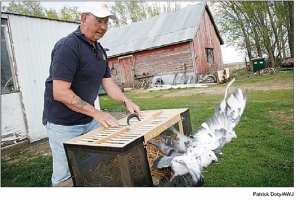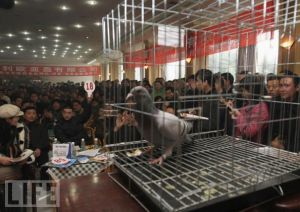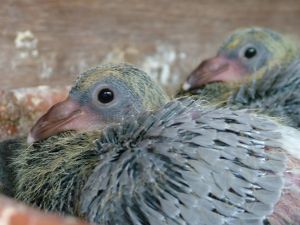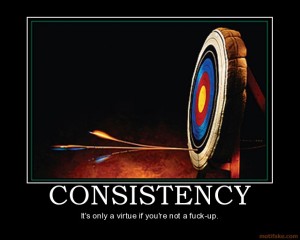The underlying connection was closed: A connection that was expected to be kept alive was closed by the server.
The underlying connection was closed: A connection that was expected to be kept alive was closed by the server.

Bill Halter releasing his pigeons
When we start road training, we start about 1/2 mile away from the loft, releasing the birds at this point 2-3 times. Remember, the routine is the same training, land, trap and peanuts.
We gradually increase the distance of our training tosses to 1, 5, 10, 20 miles. We stay at each location 3 times. On the third time at each location we are going to single toss each bird! This is the most important part of the young bird’s education. These single tosses force the bird to think on its own and not to rely on other birds to follow home. This is the first step in teaching the bird to be independent, and to build confidence in its own ability to navigate. Release each bird separately, about 10 minutes apart, and it must rely on its own homing skills. These single tosses are only made after a bird has been to the location at least 2 times with the group.
We agree that our birds must possess early physical maturity, and also, more importantly, mental ability to race and home successfully at a young age. The best way to teach this is to single toss the birds. When we train at short locations like 5, 10, 20 miles, these training tosses can be 2-3 times a day. It is better to have 2 ten mile tosses than 1 twenty mile toss for the birds to gain experience. Remember, feed and water is always available to the birds, and the routine is the same – train, land, trap, peanuts. If they know that the peanuts are waiting for them, you will have no problem with trapping.
When we look for locations to release your birds, always try to find large land marks that the birds can remember and see at great distances. After we reach the 40 mile toss location or the water, whichever comes first, all training tosses are single bird tosses. The birds must learn to fly independently from this point.
Our training tosses are now made as close to the water as possible: Varied NORTH and SOUTH OF OUR STRAIGHT LINE OF FLIGHT. We look for land markers as release points that the birds can use as they come off the water.
IMPORTANT: The birds are always sent to training tosses with a full tank of gas, fully fed and watered at all times. Hunger is the most destructive factor for our race birds. If a bird becomes hungry during a training toss or race, the bird develops memory loss, fatigue and loss of weight, all of which can be serious problems. Homing now becomes secondary to the need to survive, many times causing the loss of the bird.
If the birds fly south to north east, then they will probably head toward land first (east), then fly north. We should now single toss our birds south of the straight line of flight at tall land markers that they can recognize as they come off the water. These single tosses must be at least 10 minutes apart. If we release the birds too close together, they will not leave the area, but wait for the other birds and fly home together.
Single tossing creates and teaches mental maturity and intelligence. Many times the trainer overlooks this point. Outwardly many pigeons look good (physically), but it is what is inside that counts on race day (intelligence, confidence and independent thinking to lead, not follow the other birds.) It is important to recognize that a racing pigeon must and does navigate and think for itself independently, and not become a follower. Single tossing helps to educate the bird, and build its confidence to fly alone.
Another important area that is many times overlooked. is that the birds will eat and drink in the shipping crates that the local club uses. Successful trainers educate their young birds by obtaining a crate identical to the one used by the club. This crate is the same size, color, same location of feed and water, same release location and has the same opening as the club’s crate. They now school and educate the birds to eat and drink in these crates many times before the first race. They prepare the birds for what to expect on shipping night. This is a big advantage for the young birds to know where to look for food and water. We take no chances that the birds will find it on their own. We have prepared them in advance for this new experience.
In each situation, we have prepared our birds for new experiences in advance, all of our teaching and learning techniques help our birds to think and navigate for themselves independently from all the other birds in the race.
We must understand that we breed and train athletes. There is no difference between training and coaching a human or an animal athlete. They both need the athletic ability, proper training and coaching before the competition, excellent diets, good health and hygiene habits, plenty of rest, regular routine and a stress free environment to stay in condition and compete week after week to win the large prizes.
In the USA we have several types of races for both young birds and old birds. We place a great value on birds that compete successfully in a 1 bird derby or futurity race. Each loft enters its best bird (1 only) for this special race. The best against the best of each loft. The distances of the races range from 300-500 miles. These birds are special because they have intelligence, orientation, navigating ability, motivation, determination, desire, courage and heart. They fly as individuals or alone for distances of 300-500 miles with only their own ability. They are leaders not followers. The birds that fly these races successfully usually become excellent breeders and become very valuable in their owners’ breeding lofts. In each case the birds must prove themselves under difficult race conditions, after we provide them with the proper education.
Education: Important to Young Bird Training (Part 2 of 2) by Bob Prisco
View Related Articles Here: http://michael-pigeonracing.blogspot.com
 The vast majority of public auctions are credible events that provide an excellent opportunity for buyers and sellers to meet at a central location and conduct business. Also, they provide an excellent opportunity for buyers and sellers to arrive at the fair market value of the birds.
The vast majority of public auctions are credible events that provide an excellent opportunity for buyers and sellers to meet at a central location and conduct business. Also, they provide an excellent opportunity for buyers and sellers to arrive at the fair market value of the birds. 1. Make sure the representatives of the auction company or the sponsors and management of the auction have a vested interest to provide a positive image for the sport and have excellent reputations and high integrity.
1. Make sure the representatives of the auction company or the sponsors and management of the auction have a vested interest to provide a positive image for the sport and have excellent reputations and high integrity. To identify which pigeons are the ones to surround your program around you must breed many youngsters from them and fly them out. I have never been one to coddle my young up and coming pigeons. My best stock birds and proven champions get my respect and are given the best, but they must earn it. I don’t give any preference to youngsters off of “big name” in the sport pigeons or imports. They are flown just like the rest. They have to prove to me they are worthy of any attention.
To identify which pigeons are the ones to surround your program around you must breed many youngsters from them and fly them out. I have never been one to coddle my young up and coming pigeons. My best stock birds and proven champions get my respect and are given the best, but they must earn it. I don’t give any preference to youngsters off of “big name” in the sport pigeons or imports. They are flown just like the rest. They have to prove to me they are worthy of any attention. Bill Halter releasing his pigeons
Bill Halter releasing his pigeons So, now that we understand the basic principles of Pretzel breeding we can begin. The best proven racers you have may not be good producers. It is best of they come from a consistent family. A consistent family would be made up of birds that win on a regular basis and carry many common genes in the flock. You can rely on pigeons like these far more than any other. You can make them consistent yourself but it takes time.
So, now that we understand the basic principles of Pretzel breeding we can begin. The best proven racers you have may not be good producers. It is best of they come from a consistent family. A consistent family would be made up of birds that win on a regular basis and carry many common genes in the flock. You can rely on pigeons like these far more than any other. You can make them consistent yourself but it takes time. 6. Avoid “Auction Fever”. It will cause a buyer to spend more than he or she wants. Hold you emotions in check. Free food and alcohol affect these emotions. The food is OK, but the alcohol gets you to open up your wallet. Keep to the rule: once you have made your selections, arrive at a price you are willing to pay for each bird. Your job is to buy the bird at a fair price. Never over bid your limit or what you feel the bird is worth. If you bid and are not sure of the bid, then ask the auctioneer. His job is to sell birds, not confuse you. Bid at whatever speed is comfortable for you. Remember, the auctioneer works for the seller. It is his or her job to create both excitement and a sense of urgency to motivate people to bid quickly.
6. Avoid “Auction Fever”. It will cause a buyer to spend more than he or she wants. Hold you emotions in check. Free food and alcohol affect these emotions. The food is OK, but the alcohol gets you to open up your wallet. Keep to the rule: once you have made your selections, arrive at a price you are willing to pay for each bird. Your job is to buy the bird at a fair price. Never over bid your limit or what you feel the bird is worth. If you bid and are not sure of the bid, then ask the auctioneer. His job is to sell birds, not confuse you. Bid at whatever speed is comfortable for you. Remember, the auctioneer works for the seller. It is his or her job to create both excitement and a sense of urgency to motivate people to bid quickly. I have written many articles over the years about my experiences with pigeons. I spent most of my life building a top notch strain of rollers. I painstakingly built a family of pigeons that consistently scored higher quality multipliers by the judges in World and National competitions. One of the most important aspects of putting together a family of pigeons that will perform to the strictest standards is starting with good stock. You can’t expect to build a great family of birds using inferior stock.
I have written many articles over the years about my experiences with pigeons. I spent most of my life building a top notch strain of rollers. I painstakingly built a family of pigeons that consistently scored higher quality multipliers by the judges in World and National competitions. One of the most important aspects of putting together a family of pigeons that will perform to the strictest standards is starting with good stock. You can’t expect to build a great family of birds using inferior stock.




